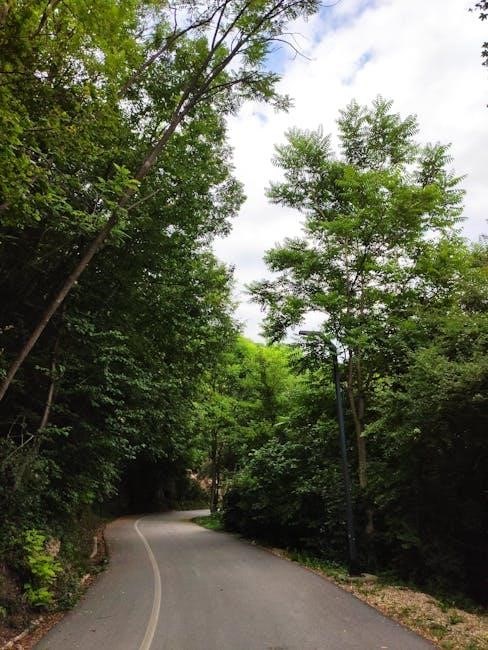My Place by Nadia Wheatley and Donna Rawlins is a groundbreaking book that explores Australia’s history through an Aboriginal lens, spanning from pre-colonial times to 2008․ First published in 1987, it won multiple awards and was adapted into a TV series, offering a unique perspective on the nation’s past․
Title and Availability
The book, titled My Place, is authored by Nadia Wheatley and illustrated by Donna Rawlins․ It is widely available in various formats, including PDF, and can be accessed through platforms like Scribd․ First published in 1987, it has been reprinted in 2008 and 2018․ The book is a children’s picture book that chronicles the history of a specific location in Sydney․ It is also available for free download as a PDF file, making it accessible to a broad audience․ Additionally, educational resources and study guides based on the book can be found online, supporting its use in classrooms and personal reading․
Historical Context
My Place by Nadia Wheatley and Donna Rawlins explores Australia’s history through the lens of a single plot of land near Sydney․ The story unfolds from pre-colonial times to the present day, tracing the profound changes that occurred after European settlement in 1788․ By focusing on one location, the book provides a unique perspective on the nation’s development, highlighting the experiences of Indigenous peoples and the impact of colonialism․ The narrative spans over 200 years, offering a vivid portrayal of how historical events shaped the land and its inhabitants․ This approach makes the book a valuable educational resource, helping readers understand Australia’s complex past and its ongoing legacy․
Significance of the Book
My Place holds profound significance as it offers a unique Indigenous perspective on Australian history, challenging conventional narratives․ By focusing on one plot of land, the book humanizes the past, making it accessible to readers of all ages․ Its vivid storytelling and rich illustrations have made it a beloved resource in classrooms, fostering empathy and understanding of Indigenous cultures․ The book’s adaptation into a TV series further amplified its reach, ensuring its message resonates widely․ Nadia Wheatley’s work has been recognized with multiple awards, solidifying its place as a cornerstone of Australian children’s literature․ Its impact extends beyond entertainment, serving as a tool for reconciliation and education about the nation’s complex history․

Author Background
Nadia Wheatley is a celebrated Australian writer known for her work in picture books and historical narratives․ Her collaboration with illustrator Donna Rawlins brought My Place to life, blending storytelling with rich visuals to educate and inspire readers about Australia’s diverse history and Indigenous cultures․ Both authors have made significant contributions to children’s literature, with their work widely acclaimed for its educational and emotional depth․
Nadia Wheatley
Nadia Wheatley is a distinguished Australian writer known for her work in picture books, novels, biographies, and historical narratives․ Her writing often explores themes of identity, history, and social justice․ Born in Sydney, Wheatley developed a passion for storytelling and began writing full-time, gaining recognition for her unique ability to weave historical facts with engaging narratives․ Her collaboration with illustrator Donna Rawlins on My Place marked a significant milestone in her career, as it provided a powerful Indigenous perspective on Australia’s history․ The book’s success led to multiple awards and adaptations, cementing Wheatley’s reputation as a pivotal figure in Australian children’s literature․ Her work continues to inspire young readers and educators, fostering a deeper understanding of the nation’s diverse heritage․
Donna Rawlins
Donna Rawlins is a renowned Australian illustrator, book designer, and educator, specializing in creating engaging books for children․ Her collaborative work with Nadia Wheatley on My Place brought the story to life through vivid illustrations, capturing the changing landscape of Australia over time․ Rawlins’ artistic style blends detail and emotion, making history accessible to young readers․ She has won numerous awards for her contributions to children’s literature and is celebrated for her ability to visually narrate complex stories․ Beyond her work as an illustrator, Rawlins is dedicated to education, often involved in projects that foster creativity and learning in children․ Her partnership with Wheatley on My Place remains one of her most impactful achievements, leaving a lasting legacy in Australian children’s literature․

Book Overview
My Place by Nadia Wheatley and Donna Rawlins is a children’s book that traces the history of a Sydney location from 1788 to 1988, exploring Australia’s past through vivid storytelling and illustrations․
Setting and Plot

My Place by Nadia Wheatley and Donna Rawlins is set in a small plot of land near Sydney, tracing its history from 1788 to 1988․ The story unfolds through the eyes of various children who have lived there, each representing a different era․ The narrative moves backward in time, starting from 1988 and ending in 1788, providing a unique perspective on Australia’s history․ The setting transforms significantly over the centuries, reflecting the impact of colonialism and cultural shifts․ Each child’s story offers a snapshot of life during their time, highlighting the land’s evolution and the people who inhabited it․ This structure allows readers to witness the profound changes in the environment and society, making the book a compelling exploration of Australia’s past․
Narrative Style
My Place employs a unique narrative style, weaving together the stories of multiple characters across different time periods․ The book moves backward in time from 1988 to 1788, with each chapter focusing on a different child who lived on the same plot of land near Sydney․ This reverse timeline allows readers to witness the transformation of the land and its people over two centuries․ The narrative is rich in detail, blending historical facts with fictional accounts to create an engaging and educational experience․ The use of first-person perspectives for each child provides an intimate connection to their lives and experiences․ Donna Rawlins’ illustrations further enhance the storytelling, offering visual context to the textual narrative․ This innovative approach makes the book both accessible and impactful for readers of all ages․
Publication History
My Place was first published in 1987, a year before the Australian Bicentenary, marking a significant moment in the nation’s historical reflection․ The book was republished in 2008 to coincide with the 20th anniversary of its initial release and again in 2018 to celebrate its 30th anniversary․ These editions have allowed the story to reach new generations, maintaining its relevance and impact․ The 2008 edition notably included updates to reflect the 2008 Apology to the Stolen Generations, further emphasizing the book’s historical significance․ Over the years, My Place has become a beloved and essential resource in Australian education and literature, with its multiple editions ensuring its enduring legacy․

Themes
My Place explores themes of Indigenous Perspectives, Colonial History, and Family and Belonging, offering a profound understanding of Australia’s past and its impact on present identities․
Indigenous Perspectives
My Place offers a powerful exploration of Indigenous Perspectives, highlighting the deep connection of Aboriginal Australians to their land․ The book traces the history of a single Sydney location, showcasing the lives of Indigenous children and their families from pre-colonial times to the modern era․ Through their stories, Wheatley and Rawlins illustrate the resilience and richness of Indigenous cultures, emphasizing the importance of the Dreaming and traditional practices․ The narrative also addresses the impact of colonization, revealing the challenges faced by Indigenous communities while celebrating their enduring spirit․ By centering Indigenous voices, My Place fosters empathy and understanding, providing a vital perspective on Australia’s history and identity․ This approach has made the book a significant resource for exploring Indigenous experiences and reconciliation․
Colonial History
My Place provides a vivid portrayal of Australia’s colonial history, tracing the arrival of British settlers in 1788 and their impact on the Indigenous population․ The book explores the transformation of a single plot of land near Sydney, illustrating how colonial expansion reshaped the environment and displaced Aboriginal communities․ Through the stories of children living on this land, Wheatley and Rawlins reveal the struggles and injustices faced by Indigenous Australians during this period․ The narrative also highlights the broader colonial narrative, including the Bicentenary of 1988, which marked 200 years of European settlement․ By blending historical facts with personal stories, My Place offers a poignant reflection on the complexities and legacies of colonialism in Australia, making it an essential resource for understanding this pivotal era․
Family and Belonging
My Place explores themes of family and belonging through the shared history of a single plot of land in Sydney․ The book vividly portrays how generations of families, both Indigenous and settler, form deep emotional connections to the land․ Through the stories of children who have lived there, Wheatley and Rawlins highlight the importance of family ties and the sense of belonging that comes from shared experiences․ The narrative emphasizes how these connections transcend time and culture, creating a sense of continuity despite the changes brought by colonialism․ By focusing on personal stories, My Place illustrates the enduring strength of family bonds and the universal human desire to belong to a place and a community, making it a powerful exploration of identity and heritage․ This theme resonates deeply with readers, offering a relatable lens through which to view Australia’s complex history․

Adaptations
My Place was adapted into a critically acclaimed TV series, furthering its impact and educational value․ Additional resources, like PDF study guides, enhance its accessibility for students and educators․
TV Series
The award-winning book My Place was adapted into a critically acclaimed TV series by the Australian Broadcasting Corporation (ABC)․ Produced by Penny Chapman and Helen Panckhurst, the series premiered on ABC3 and consisted of 13 episodes․ Each episode focused on a different child’s story, spanning 240 years of Australian history․ The series captured the essence of the book, vividly portraying the lives of children living on the same plot of land from pre-colonial times to 1988․ The show won several awards, including a Logie Award, and became a significant educational resource․ It complemented the book’s narrative, offering a visual and engaging way to explore Australia’s history and cultural heritage․ The TV series remains a powerful adaptation, enhancing the book’s impact and accessibility for new generations․
Educational Resources
My Place has inspired a wealth of educational resources, including PDF activity guides and lesson plans․ A 14-page PDF document offers activities based on the book, designed for classroom use․ These resources encourage students to explore themes such as history, culture, and identity․ Teachers can access study guides, creative writing prompts, and interactive exercises that align with curriculum goals․ Many schools have used My Place to teach Australian history, fostering empathy and understanding of Indigenous perspectives․ The book’s visual and narrative style makes it an ideal tool for engaging students in cross-disciplinary learning․ Educational resources extend the book’s impact, helping students connect with Australia’s past and present․ These materials are widely available online, supporting educators in integrating My Place into their teaching practices effectively․
Educational Use
My Place is widely used in schools, with PDF resources and activities supporting its integration into curricula․ Teachers and students value its historical and cultural insights, enriching learning experiences․
Classroom Activities
Classroom activities based on My Place encourage students to explore Australia’s history and cultural heritage․ Teachers use the book to create engaging lessons, such as timeline projects, mapwork, and creative writing․ Students can analyze the changing perspectives of characters over time, fostering empathy and historical understanding․ Group discussions and debates on themes like colonialism and Indigenous rights are common․ Art activities, such as illustrating scenes from the book, help students visually interpret the narrative․ Role-playing exercises allow students to imagine life in different eras, deepening their connection to the story․ These activities align with curriculum goals, promoting critical thinking, creativity, and cultural awareness․ PDF resources and study guides provide structured support for educators, ensuring a comprehensive learning experience․
Study Guides and Resources
Study guides and resources for My Place are widely available, offering educators and students structured support for exploring the book․ PDF documents provide detailed lesson plans, activities, and discussion points, aligning with curriculum goals․ These resources include historical context, comprehension questions, and creative tasks, enabling deeper engagement with the text․ Many guides focus on themes like Indigenous perspectives and colonial history, fostering critical thinking․ Walker Books and other publishers offer downloadable resources, making it easy for teachers to implement the book in classrooms․ Additionally, the availability of the My Place eBook in PDF format allows students to access the text conveniently, enhancing learning experiences․ These resources are invaluable for educators seeking to integrate the book into their teaching strategies effectively․

Impact and Legacy
My Place has won multiple awards and been adapted into a TV series, making it a significant cultural and educational resource․ Its exploration of Indigenous perspectives has left a lasting impact on Australian literature and education․
Awards and Recognition
My Place by Nadia Wheatley and Donna Rawlins has received widespread acclaim and numerous awards․ It won the CBC Picture Book of the Year and was recognized for its innovative storytelling and illustrations․ The book’s adaptation into a TV series further cemented its impact, earning a Logie Award․ These accolades highlight its significance in Australian literature and education, making it a cornerstone of cultural and historical understanding․ The awards underscore the book’s ability to resonate with diverse audiences, solidifying its legacy as a vital resource for exploring Australia’s past and Indigenous perspectives․ Its recognition continues to inspire new generations of readers and learners․